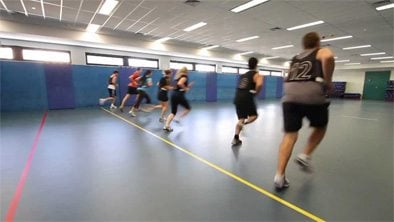Amid recent pressure on the Government over the wages of public sector workers, it has been widely reported that prison officer salaries are set to increase beyond the 1% cap on public sector pay rises. As a result, applications for this position are expected to increase nationwide as we move towards the new year and beyond. In response, we wanted to create this resource on a key part of this application – the Prison Officer Fitness Test.

This mandatory portion of the selection process, which you must pass, takes place during the prison officer assessment day, otherwise known as the Recruitment Assessment Day (RAD). You will be invited to attend the RAD should recruiters be satisfied with your application form, and you have successfully navigated the online Prison Officer Selection Test (POST).
The Prison Officer Fitness Test is generally the last activity of the RAD, and is split up into five distinct sections, which are as follows:
- The Grip Strength Test;
- The Prison Officer Bleep Test;
- The Dyno Test;
- The Speed Test;
- The Shield Test.
These sections all have minimum requirements, and have been designed to assess whether you have the level of physical strength and fitness required by the role, as identified by the National Offender Management Service (NOMS).
Let’s now look in closer detail at what each of these tests entail.
The Grip Strength Test
This is a simple test which is rather self-explanatory. It involves your squeezing of a specialised measuring device called a grip dynamometer. This device will gauge the strength of both your forearms and hands. In order to be successful in this test, you need to generate a force of at least 25kg with each hand.
The Prison Officer Bleep Test
This test, also referred to as the ‘Shuttle Run Test’ is one you have probably done before or at least heard of. Of course, the dreaded bleep test will assess your levels of aerobic endurance. In time with the bleeps, which get progressively faster as the levels rise, you must run back and forth across a distance of 15m, failing when you can no longer keep pace with the bleeps. The minimum requirement for this test is to reach a minimum level of around 5 or 6, which is actually considered a below-average score.
The Dyno Test
This test is designed to measure your upper body strength. You will have to demonstrate how well your arm muscles can push and pull by operating an arm press weight machine as you would see in a gym. In order to be successful in this test you will need to be able to push and pull at least 35kg.
The Speed Test
Similar to the Prison Officer Bleep Test, the Speed Test will measure your fitness as well as how fast you can run. You will have to navigate a short ‘obstacle course’, which consists of plastic cones and several changes of direction. This is perhaps the least taxing of the tests, as it is decidedly less strenuous than the Bleep Test. To pass this one, you will have a maximum time of 30-40 seconds to navigate the course, which is plenty of time.
The Shield Test
This test will allow recruiters to find out how well you can cope with riot gear. In it, you will have to prove you can hold a 6-8kg riot shield capably – usually you will have to adopt a secure stance and hold the shield in front of you for 60 seconds. You may also be asked to perform some basic defensive moves with the shield, in order for recruiters to see if your level of control over the shield is up to scratch.

Prison Officer Fitness Test Advice
To reiterate, the tests have been put together to get a sense of your all-round fitness and strength. Preparation for these tests will also overlap – going out running will get you in shape for the Bleep and Speed Tests, while basic strength exercises will stand you in good stead for the other three. If you already have a decent level of base fitness, then you will probably not have to train too much in order to be successful in the Prison Officer Fitness Test.
However, you may want to aim to do more than simply get through the tests. Performing over and above these expectations will of course do you no harm, and could even make the difference between you and another candidate when it comes to dishing out jobs.
When NOMS recruiters are making the decisions on who to hire, they take a candidate’s entire application into account. Your application form, performances in tests and interviews, as well as your performance in the fitness tests will all be considered at once.
So, in truth, the Prison Officer Fitness Test represents a good opportunity for you to put some distance between yourself and other candidates, who may not realise that you can do more than simply pass or fail the fitness tests. Should you train hard and excel, you could find yourself with a job at the expense of other applicants, some of whom may have edged you out in other areas.
Simply put – there is simply no downside to overachieving in this very passable Prison Officer Fitness test. It could be the difference between disappointment and success!
Follow the link for more guidance on the Prison Officer Fitness test as well as the Prison Officer selection process as a whole.
Like How2Become on Facebook!
